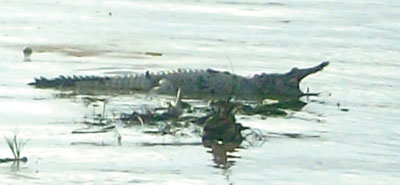News
Nilwala crocs strike back
Another woman fell victim to a Nilawala River Croc. According to villagers the woman had gone to the river on June 21 around 9 a.m. either to fetch water or wash clothes. The villagers with the support of the Disaster Management Committee and police had launched a search party and around 7 p.m. the body was recovered near the Kadduwa Bridge.
According to eyewitnesses the body had been eaten by a crocodile.The victim, a 40-year-old single mother of two lived in a nearby village and the river is the main source of water for the villagers. The woman had stepped into the water despite a Crocodile Exclusion Enclosure (CEE) being situated about 100 metres away from the site of the accident and a warning signboard about the crocodile infested water.

The Nilwala is the home to Salt Water Crocodile (Crocodylus porosus)
“This death could have been averted. It seems to have happened due to ignorance or unawareness,” says Dinal Samarasinghe – a member of the Crocodile Specialist Group, Species Survival Commission, IUCN who had visited the area following the tragedy.
Leading herpetologist Anslem de Silva, who is also the Regional Chairman of South Asia and Iran of the Crocodile Specialist group of IUCN/SSC told the Sunday Times the fault was mainly with people. Dr. De Silva who has investigated more than 170 crocodile attacks in areas ranging from from Jaffna to Matara said many unfortunate incidents occurred due to people ignoring CEE sites and warning signboards.
The islandwide study conducted by Dr. De Silva from 2009 to March 2013 also revealed that 148 (84%) of the victims were male while 26 (15%) were female. Hundred and thirteen (64%) of the attacks occurred when the victims were bathing or washing clothes, 38 (22%) while fishing. Forty nine deaths were reported of the 176 attacks.
Crocodiles are one of the top predators in the world and a human is just another prey for it, so it is deadly to underestimate the intelligence of a crocodile, Dr. De Silva warns.
The Nilwala is the home to Salt Water Crocodile (Crocodylus porosus) and has been the site for many crocodile human conflicts. It reached a peak last year following the death of a schoolgirl who was preyed on while washing her face in the river. The huge crocodile hunt that followed, attracted lots of media attention and resulted in the capture of a huge crocodile in the Malimbada area last April.
The hate-game continued resulting in the death of at least five crocodiles in the area mainly by poisoning. The Kamburupitiya Divisional Secretariat says, they had conducted many awareness programmes for villagers living along the river but many use unprotected areas for convenience.
The saltwater crocodile (Crocodylus porosus)
This species is a highly threatened reptile in Sri Lanka and exists only in a few suitable habitats. It is categorised as endangered in the 2012 National Red List according to its distribution within the island. Although following a big outcry last year, there were plans to build a crocodile enclosure to keep rogue crocs that had attacked people, there are little signs of this being implemented.
Follow @timesonlinelk
comments powered by Disqus

